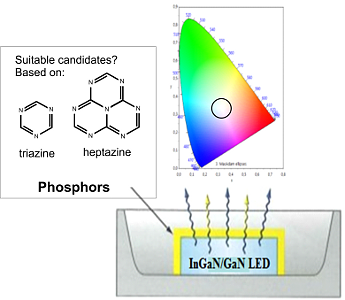Computational Screening of Organic Compounds used in New Phosphor Materials
Computational Screening of Organic Compounds used in New Phosphor Materials
Promotor(en): K. Hemelsoet, S. Cottenier /15_SPEC06 / SpectroscopyLuminescent materials, also known as phosphors, have very interesting properties for a variety of applications. Traditional application domains are LED lighting and imaging, where the phosphors convert blue light into green, yellow or red light in order to achieve a white emission spectrum from one (blue) pumping LED (see Figure 1). In this master thesis project, we focus on simulating and screening organic compounds for their use as phosphor components using advanced theoretical methods. In particular, the organic material is used to convert the blue light emitted by the LED to light in the yellow to red range, contributing to the generation of white light emission.
To date, many questions remain on the precise physical processes responsible for the particular luminescent behavior of solid-state phosphors, and advanced theoretical simulations can be used to provide a deeper understanding. We have in recent years witnessed a lot of progress in the field of simulating the optical characteristics of molecules and materials. Ab initio methods can be used to rationalize and elucidate the structure-activity relationship of complex materials. In this view, Density Functional Theory (DFT) is one of the most interesting electronic structure methods due to its excellent accuracy/computational cost ratio. This research requires insight in the excited state behaviour of the materials, since they directly involve transitions between an excited state and the ground state. The excited states can be computed using the time-dependent variant of DFT (i.e., TD-DFT), which is known to provide accurate optical properties of molecules of relatively large size.
The ultimate goal of the simulations is the rational design of new phosphor materials with improved functionalities, for instance a higher quantum yield or luminescence in a particular wavelength range.

Figure 1. Schematical representation of the blue emitting LED combined with a suitable phosphor material (indicated in yellow) for the generation of white light emission.Aim The goal of this master thesis is to study the optical behavior of various organics using advanced ab initio simulations. Selected organic dyes will be modeled using DFT, starting with triazine- and heptazine molecules. A first step will be to assess the predictive power of the simulations, comparing the computed spectra of these molecules in solution with available literature data. Next, the actual search for organics with improved functionalities can start, aiming at organics emitting light in the yellow to red range. This search involves varying terminal groups of the original triazine- and heptazine molecules and screening the newly proposed phosphor candidates by calculating their stability and optical properties of the molecules in solution. In a later phase, the properties of the organics in bulk phase can be tackled for some well-chosen case studies. These simulations require the use of periodic unit cells, and also here DFT will be the selected theoretical methodology.
This thesis topic is challenging and requires good insight in the underlying theory, creativity and technical skills for performing the ab initio simulations. It is not necessary to have experience with molecular modelling; this will be learned during the thesis research. There will be a close interaction and good coaching with other researchers working on this topic, and depending on the specific interests of the interested student, particular items can be selected for this master thesis research. For example, the focus can lie on the screening of a large set of organic compounds, or on an in-depth analysis of various properties – optical and energetic – of a selected set of organics. The interested student will learn a lot about materials crucial in light emitting processes and will gain a deep understanding on the underlying physical processes.
- Study programmeMaster of Science in Engineering Physics [EMPHYS], Master of Science in Physics and Astronomy [CMFYST]ClustersFor Engineering Physics students, this thesis is closely related to the cluster(s) (1) Modelling, (2) Photonics, (3) FundamentalsKeywordsMolecular modeling, Optical spectroscopyRecommended coursesSimulations and modeling for the nanoscale, Luminescence

